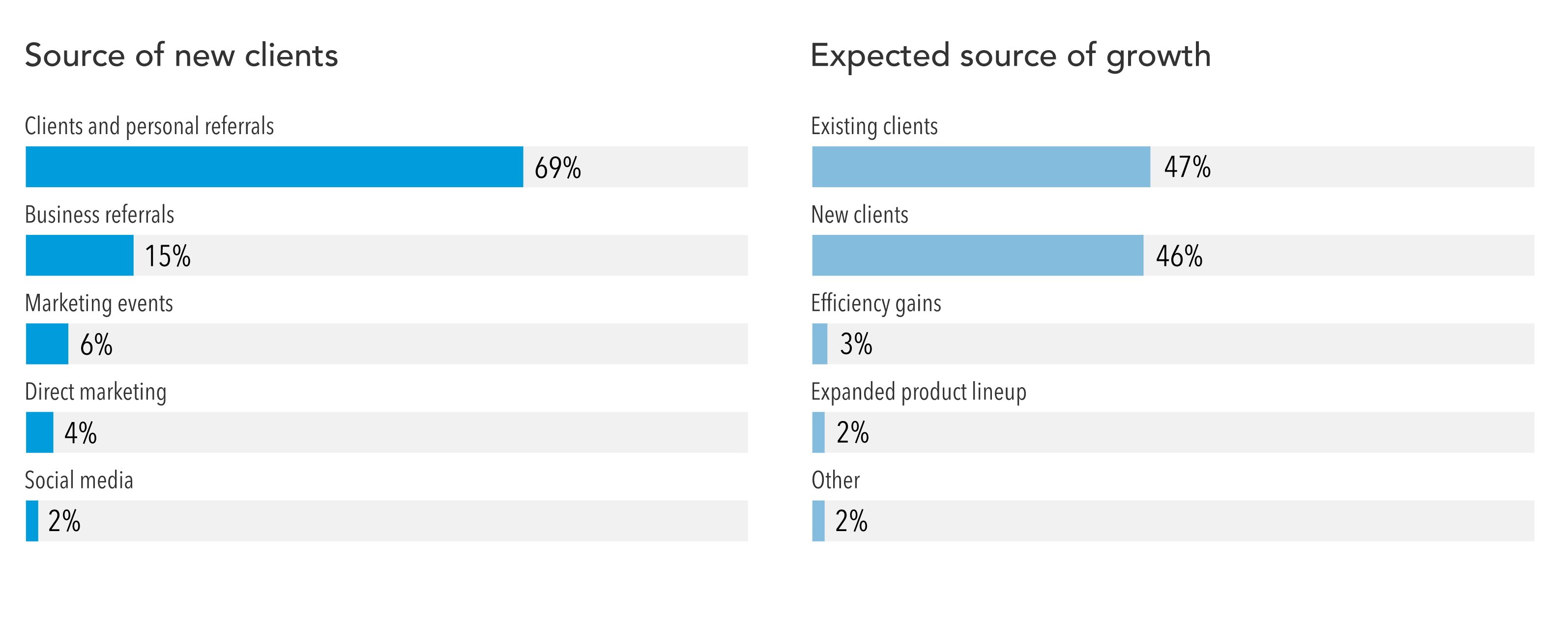
It’s no big secret that client relationships are essential to the success of every wealth management practice; without clients, you wouldn’t have a business. And the acquisition of new clients can certainly be the make-or-break difference that perpetuates your business into the future (especially when we consider asset decline from retiree distributions and the potential loss of clients and assets as wealth transitions to the next-gen).
According to a study by Capital Group, practices that make client acquisition a focus and utilize marketing-based strategies gain a greater-than-average share of new clients and achieve higher-than-average growth.
However, many practices rely on referrals (from current clients and business partners) as the primary (and sometimes the sole) method to bring in new clients.
In fact, the Capital Group study found that 83% of new clients are generated from referrals. By contrast, marketing-based client acquisition strategies, including events, direct marketing, and social media outreach, accounted for only 12% of new clients.
 Source: https://www.capitalgroup.com/advisor/practicelab/pathways-to-growth.html
Source: https://www.capitalgroup.com/advisor/practicelab/pathways-to-growth.html
Client Acquisition Shouldn’t Be Left to Chance
Ironically enough, respondents to the Capital Group study expected new clients to be a primary growth driver. But the high dependence on referrals suggests a lack of intentionality, especially as a driver of business growth.
The fact is, referrals are reactive, not proactive. Think about it – many advisors are not entirely comfortable asking for referrals; at most, you may see a sentence in their email signature block referencing that “referrals are the best compliments”. Receiving a referral requires minimal effort, but in order to be successful at something – in this case, acquiring new clients – you usually have to invest in that success and put in some hard work.
Valuation Impact
Perhaps the most surprising aspect of referrals in our industry is the impact on a Practice’s valuation. Many advisors are shocked to learn that a high dependence on referrals is a negative factor for valuation, asking “Wait, isn’t it a good thing that my clients give me referrals?!” Yes, client referrals are a great thing… when a business is growing. Remember though that valuation looks at a Practice through the eyes of a buyer. In reality, most client referrals will stop (at least for a period of time) when a new owner steps in; after all, those clients don’t know your successor and likely won’t feel comfortable making referrals yet. So, if you enjoy an impressive growth rate because of clients that love you and provide referrals, you may be inadvertently leaving your eventual successor with no way to continue that growth (and that hurts your value in a sale).
It’s important to note that not all referral sources are the same either. Referrals that come from a Center of Influence (COI), e.g., attorneys, accountants, etc., tend to be a little stickier under a new owner, especially if other key employees are staying post-transaction. As such, these are going to have less of a negative impact on valuation. Our general rule-of-thumb at Truelytics, is that client referrals shouldn’t make up more than 40-50% of your new business. The balance should be a blend of COI referrals and the Practice’s own efforts to drive client acquisition.
Client Acquisition Techniques
Now that we’ve established that client acquisition requires a more focused effort, let’s dive into initiatives you can take to expand your approach and achieve success.
Increase Marketing-Related Activity
Not just any type of marketing will do though. To be effective you need targeted advertising. That means defining your target audience and using the correct channels to reach them. Additionally, your marketing should consist of high-quality content; think video content and blog posts that really tackle the issues that potential clients want to learn about.
Focus on SEO
Creating high-quality content is only half the battle; you now need to get it in front of the right people (prospective clients). This is where Search Engine Optimization (SEO) comes in to make your content more discoverable and visible to your target audience. For our non-techie readers, SEO helps your content show up closer to the top of the result list on search engines like Google.
Create a Landing Page for Lead Gen
Once your website contains lots of useful information with your new high-quality content, you need to make it easy for prospective clients to connect. Consider adding a landing page to generate leads by capturing contact information to fill the top of the funnel. For certain content, you may want to require the website visitor to provide their name and email address to “unlock” an article. This makes it easier for you to follow-up with prospects who want the expertise you can provide!
Utilize Social Media
While our industry may have more stringent requirements for the content we post on social media (i.e., avoiding “advice”), it is still a critical component of connecting with prospective clients. Don’t forget to utilize platforms like Facebook, Twitter, and LinkedIn to get your brand in front of prospects. I have one client who uses his business social media only to post pictures of his dogs, who serve as the office mascots. You can bet he always has something to connect with prospective clients about – their love for their dogs!
Host Events
What better way is there to get in front of prospective clients than to host an event? Whether it’s an open house or educational seminar (even a virtual one!), events are a great way to allow potential clients to get to know you (and your “brand”) on a personal level. Contrary to what you may think, hosting an event doesn’t necessarily mean you need to spend a lot of money either. Be creative and give your prospects a low-pressure opportunity to decide that they want to work with you.
It’s a Marathon, Not a Sprint
These initiatives require an investment in your business – both from a time commitment, and likely that of a cost commitment. It is unlikely that you’ll achieve overnight success. This may be a learning process for you too (marketing is a skill that is learned) – you may need to try different things before you find your groove. But don’t leave it to chance; make sure that you’re deliberate with diversifying your client acquisition sources to maximize the stability and value of your business.
These Stories on Practice Management